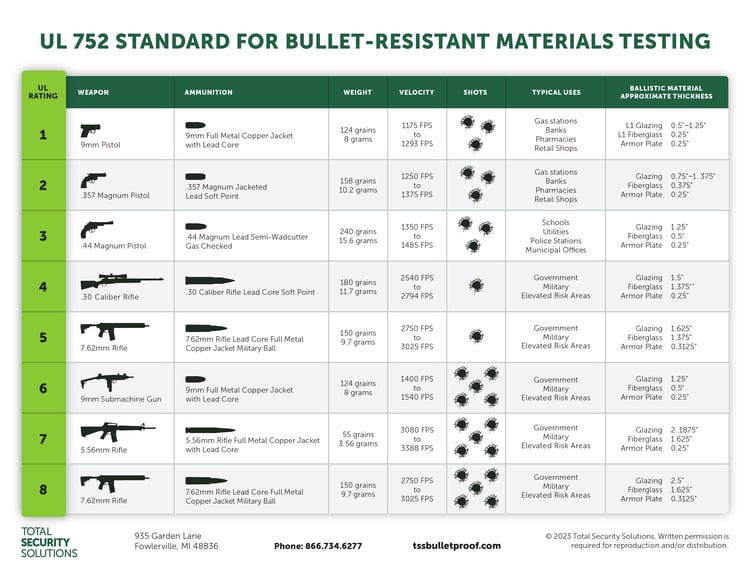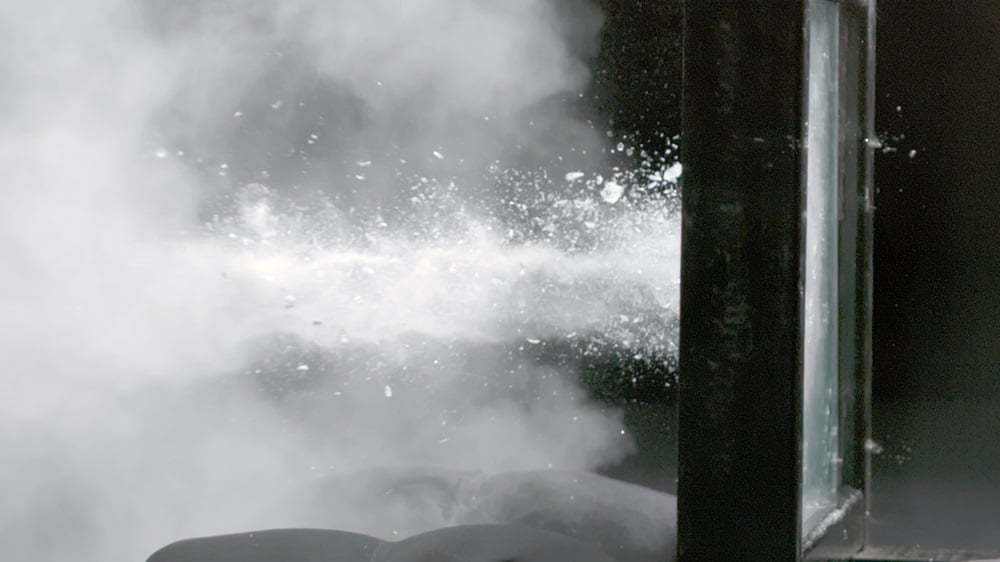UL, ASTM, and NIJ are the three most commercially referenced organizations that have published standards for ballistic barrier materials and systems. These standards outline the level of bullet resistance you can expect, including the number of shots stopped from a certain caliber of firearm under specific conditions. But what ballistic standard is right for your bulletproofing project? What are the differences between UL, ASTM, and NIJ? This blog breaks it all down.
The UL 752 Is Typically the Gold Standard for Evaluating Structural Ballistic Safety
All bulletproofing standards have their uses; it just depends on what your needs are.
- Materials tested to the UL 752 standard are used in bullet-resistant building construction.
- The NIJ standard covers both personal protective armor and protective materials.
- ASTM standards are useful when comparing materials in certain applications.
At TSS, our products are independently tested to the UL 752 standard.
About the UL 752 Bulletproofing Standard
The UL 752 Standard for Bullet-Resisting Equipment covers individual materials such as a fiberglass panel or pieces of laminated glass. It also applies to systems made of multiple materials, such as bullet-resistant doors with a frame or a set-in-place ballistic teller window.
The UL 752 standard specifically notes that “bullet-resisting” means that the material prevents:
- Complete penetration by a bullet or bullet fragment.
- Spalling (i.e., fragmentation) on the protected side of the barrier sufficient enough to injure a person “standing directly behind the bullet-resisting barrier.”
UL 752 recognizes 10 levels of bullet resistance. These levels are not incremental. For instance, material rated at Level 5 would not inherently pass the Level 4 test due to the difference in projectile and velocity.
Levels 1 through 3 are designed to stop three-shot clusters from various common handguns.
Levels 4 through 8 are designed to stop one to five shots from various rifles and submachine guns (including high-powered, sniper, and tactical rifles). Levels 9 and 10 are primarily used in military or certain government applications.

How the NIJ Standard Compares to UL 752
NIJ Standard 0108.01 applies to all ballistic resistant materials (armor) intended to provide protection against gunfire, with the exception of police body armor and ballistic helmets, which are the topic of individual NIJ performance standards. This standard also does not outline the specific procedures for testing common architectural products.
The NIJ standard specifies that “Only a complete perforation of the witness panel, whether by bullet fragments or material from the test sample (spall), shall be classified as a ‘penetration.’ Impacts which produce any other results will be classified as ‘no penetration,” regardless of the risk of injury.
The NIJ standard is a valid measure of bullet resistance, but it may not provide the level of detail that you need to be confident in the security of your facility.
How the ASTM Standards Compare to UL 752
There are several ASTM standards that are important to physical security and safety in building construction. These include:
- F1233 Standard Test Method for Security Glazing Materials and Systems
- F1915 Standard Test Methods for Glazing for Detention Facilities
- F1642 Standard Test Method for Glazing and Glazing Systems Subject to Airblast Loadings
- D256 Standard Test Methods for Determining the Izod Pendulum Impact Resistance of Plastics
The ASTM F1233 standard is most relevant to ballistic barrier systems. This standard focuses on forced entry resistance but includes several ballistic ratings. ASTM F1233 also identifies a standard for ballistic attacks in a forced-entry rating calculation. The ballistic ratings include 12 “classes,” which are similar to the UL 752 Levels. Unlike UL 752, these classes generally only require the material to stop between one and three shots.
Why Many Ballistics Experts Prefer UL 752
While every organization hopes their ballistic barrier system never gets “field tested,” the most important thing is that in an adverse event, it performs as promised.
In order to be confident in the safety of your ballistic barrier system, you need material that is rated to a modern, independently-tested standard. You need to know what level of attack it can protect against and where it may fall short.
For these reasons, many experts rely on UL 752 to tell them what they need to know about the capabilities of their bulletproof barrier systems. At Total Security Solutions, this is our go-to standard. We want our customers to be completely confident in the proven safety of their bullet-resistant system and that means testing to the UL 752 standard.
What UL Level Barrier Do I Need?
You may think that when it comes to ballistic barrier security, you need the highest level of bullet resistance. That often comes at a high cost in both material and structural engineering, which may not make sense for your organization’s budget or threat level.
We always recommend identifying the potential threats you’d like to mitigate first. From there, you can determine which level of protection meets your requirements. Understanding the specific bulletproofing standards, especially UL 752, will be critical as you consider your options.
TSS Can Help You Understand UL Levels for Your Bulletproofing Project
If you’re not sure what UL level of protection you need, don’t worry. TSS’s team of ballistic experts can help you understand your threat level, determine what level of protection is right for you, and build a bulletproof system that meets your needs. To get started, send us a message. We look forward to speaking with you!

